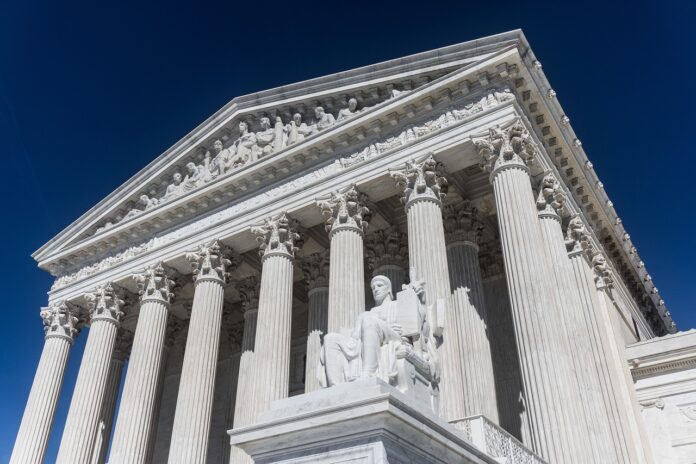On June 30, the Supreme Court announced its final opinions on two major cases: it ruled in favor of a web designer who refused to create websites for LGBTQ+ couples and struck down President Joe Biden’s student loan forgiveness plan.
The decision arrived a day after the court struck down affirmative action in college admissions.
Student loan forgiveness denied
In a 6-3 decision, with conservative justices in the majority, the Supreme Court slashed Biden’s $400 billion plan to help the estimated 43 million borrowers who incurred debt as students.
The court held that the administration needs Congressional approval before undertaking such a costly program, ruling that the Biden administration overstepped its authority in trying to cancel the repayments.
Twenty million borrowers could’ve had their debt erased entirely, according to the Biden administration. Currently, Americans owe $1.75 trillion in total student loan debt, including federal and private loans.
Hector Marin is among those who was looking forward to having his student debt canceled or reduced. A UC Santa Cruz alumni and a Pell Grant recipient, he likely would have qualified to have all of his $20,000 of debt forgiven. The full-time consultant says he’s considering his options, as he’ll be up against a $200 monthly bill, as soon as he’s forced to resume payments.
“I’m going to have to take money from savings, and also maybe get a second job,” Marin said. “I’m also having thoughts (of) moving back in with my parents in Riverside, instead of living independently here in Santa Cruz, because the cost of living is getting worse. And now, if you add that with the new expenses at the same time, it takes a toll, not only financially on the individual, but also socially and mentally—and that’s a lot of pressure.”
According to collegefactual.com, 37% of incoming students take out a loan to help with freshman year costs, averaging $6,294 each.
Marin, of Latinx descent and a first-generation college student, says that the recent decision is going to hurt minorities and low-income people the most. He comes from a working class family that was financially unable to help him cover living expenses, so even though his Pell Grants covered tuition, he had to take out loans to cover the cost of living.
“The relief plan would have especially benefited first-generation college graduates and those from low-income backgrounds, who are more likely to take on debt to complete their education,” UCSC spokesperson Scott Hernandez-Jason says.
Biden responded to the Supreme Court’s decision by announcing the administration will pursue relieving debt through a different law, the Higher Education Act of 1965.
Student debt payments, which have been on pause since the pandemic, are expected to resume this fall.
Ruling for web designer
The Supreme Court also ruled, in a 6-3 decision, in favor of a Christian web designer who refused to create websites celebrating same-sex weddings.
Cheryl Fraenzl, executive director of the Diversity Center in Santa Cruz, said the decision flies in the face of longstanding tradition of having businesses be open equally to everyone.
It is also counter to the societal position on LGBTQ rights in the U.S., where 80% support nondiscrimination protections, she says.
“The decision sends a distressing signal that certain business owners’ religious beliefs can be used as a license to discriminate, further marginalizing an already vulnerable community,” she said.
And while the narrow ruling likely applies to a small number of businesses, the dissenting justices say that it creates an unprecedented exception to nondiscrimination laws, Fraenzl said.
“This decision is out of step with the values held by the majority of people in this country, who understand that discrimination has no place in our society,” she said. “Denying service to anyone because of who they are is out of step with what the overwhelming majority of Americans, including business owners, believe.”
The same protections, she said, forbid racial discrimination, protect religious expression and treat women as equal citizens.
“We must all do our part to ensure this ruling is not used to open the door to further discrimination in the marketplace,” she said. “Otherwise, we risk turning back to a time when businesses regularly denied goods and services to people because of not just their LGBTQ+ status but also their religion, race, national origin, sex and more.”
Affirmative action
On June 29, the Supreme Court struck down affirmative action programs at the University of North Carolina and Harvard in a major blow to local minority activists, ending the systematic consideration of race in the admissions process.
The court ruled that both programs violate the Equal Protection Clause of the Constitution and are therefore unlawful. The vote was 6-3 in the UNC case and 6-2 in the Harvard case, in which liberal Justice Ketanji Brown Jackson recused herself because she served on Harvard’s Board of Overseers.
The purpose of the affirmative action program under consideration by the court, which traces back to an executive order by President Lyndon B. Johnson, was to increase the representation of women and minorities in a number of American institutions as a way to correct for historical discrimination.
But in California, consideration of race in admissions has been banned since 1996 through the voter-approved Proposition 209.
Still, UCSC issued a statement condemning the decision. The university says the decision is the latest attack on efforts reducing systemic barriers to opportunity experienced by historically marginalized populations, including communities of color.
“While today’s court decision requires universities across the country to follow this new interpretation of the law, it also requires campus administrators, faculty and staff to continue our efforts to expand outreach and opportunity in whatever ways we can,” the statement reads. “We proudly affirm that UC Santa Cruz will continue to be a leader in creating environments in which all students can grow and thrive.”
Biden called the decision a “severe disappointment,” adding that his administration would provide guidance on how colleges could maintain diversity without violating the ruling.
A recent Pew Research study found that half Americans disapprove of universities and colleges considering racial and ethnic backgrounds into account when making admission decisions. Those Americans who disagreed with the process were primarily white respondents, people without college degrees and Republicans.
At UCSC, the student body was majority white, according to DATAUSA from the 2020 school year. In 2020, white students represented 31.1%, Hispanic or Latino students represented 25.7% and Asian students represented 21.6% of the student body. Black students only represented 0.104% of UCSC’s student body.
At West Valley College, data from that same 2020 school year found 36% were white, 31% Hispanic or Latino, 22% Asian and 3% Black.










